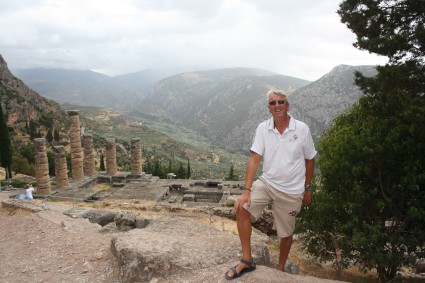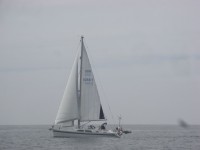
Max Adventure
28 September 2013 | Serifos
26 September 2013 | Kithnos
18 September 2013 | Corinth
16 September 2013
15 September 2013 | Galaxhidi
14 September 2013 | Entrance to Gulf of Corinth
13 September 2013 | Patras
10 September 2013
31 August 2013 | Preveza
30 August 2013 | The Meteora
25 August 2013 | North Ionian
18 August 2013 | Northern Ionian
07 August 2013 | Ionian
19 July 2013 | Ionian
28 June 2013 | Paleros
19 June 2013 | Vlieho
18 June 2013 | Vlieho
18 June 2013 | Skorpios Island
16 June 2013 | Nidri
16 June 2013 | Lefkada and Maganisi
A Day in Delphi
16 September 2013
Carole/Sunny/Showery

It would be nigh on impossible to pass by so close to Delphi without visiting this impressive ancient site. So, Dragonfly, Jolli Jumper and ourselves set off on the bus from the square in Galaxhidi to go up the mountain and explore.
I had always known of Delphi, as have most people, but I didn’t actually know much about the history of the place.
Delphi occupies a high mountain terrace dwarfed either side by the ominous crags of Mount Parnassos. For centuries this was the religious and spiritual centre of the ancient Greek world. According to tradition, Delphi was the geographical centre of the world, the omphalos (“navel”), the meeting point of two eagles dispatched by Zeus from the ends of the universe to find the centre of the world!
However, it would seem that it was the prescence of the oracle that really put Delphi on the map. The first oracle established here was dedicated to Gaia (Mother Earth) and Poseidon (Earth Shaker). The serpent Python, son of Gaia, lived in a nearby chasm that exuded strange vapours, and communication was made through the Pythian priestess. Python was later slain by young Apollo, who supposedly arrived in the form of a dolphin, hence the name Delphi.
Apollo replaced Python in the ninth century BC and following this the sanctuary became the centre for an association of city states, known as the Amphyctionic League. The oracle was increasingly respected and a steady stream of pilgrims made their way to Delphi to receive divine direction in matters of war, worship, love or business.
As far as we could tell the oracle worked like this: the Pythian priestess was positioned on a tripod over the oracular chasm. The vapours from the chasm reduced her to frenzied, incoherent and undoubtedly prophetic mutterings. Crucially, an attendant priest would then ‘interpret’ her utterings, usually in an ambiguous answer, to the waiting pilgrim. Said pilgrim will have paid a set fee and made a sacrifice, a goat, boar or even a bull, and then waited to submit a question on a lead tablet.
The oracle must have offered predominantly sound advice or I guess it would not have retained its popularity for so long. This may have been because the Delphic priests, who ‘intertreted’ the answers, were better informed than any other corporate body at that time. With the Amphyctionic League acting as a ‘United Nations’ of the Greek city states they were able to amass a huge wealth of political, economic and social information that informed their ‘interpretations’.
Delphi also had huge financial wealth. The Greek city states rivalled each other in their display of ostentatious gifts to Delphi. We walked through the paved Sacred Way that used to house statues of gold, bronze and painted marble figures. Individual Greek states used these memorials as a display of strength, for example after defeating another state in battle, so it appears that as time went on the monuments became more lavish to outdo each other.
Halfway up the site there is the amazing Polygonal Wall, whose irregular interlocking blocks have withstood, intact, all earthquakes. No mean feat round here where every other place seems to have been destroyed by earthquakes over the years! It is covered with inscriptions, like so many of the rocks here, but these mostly refer to the emancipation of slaves; Delphi was one of the few places where such freedom could be made official by an inscribed register.
Most of the Delphi site that we saw was rediscovered towards the end of the seventeenth century and explored, haphazardly from 1838 onwards; real excavation began only in 1892 when the French School of Archaeology leased the land. By 1903 most of the excavations and reconstructions we saw were complete.
We spent ages walking up the rough stone steps and paths as we explored, and listened in to tour guides telling their groups about the history and meaning of the different sites – most useful and free! We were nearly at the top when the weather changed and the heavens opened! Sheltering under the few trees around kept us reasonably dry until we could walk down in between the showers and make for the museum. We spent an absorbed couple of hours in there – it was so well done. Sue was able to sketch in the dry, one of the staff even brought her a seat, and there was so much to choose from to draw.
Catching the bus back down the mountain gave us a lovely view way out to sea over the Gulf of Corinth and a chance to reflect on the day. We had been lucky with the weather as we had seen most of the site before the rain came: it was definitely one of the must see sights of Greece!
I had always known of Delphi, as have most people, but I didn’t actually know much about the history of the place.
Delphi occupies a high mountain terrace dwarfed either side by the ominous crags of Mount Parnassos. For centuries this was the religious and spiritual centre of the ancient Greek world. According to tradition, Delphi was the geographical centre of the world, the omphalos (“navel”), the meeting point of two eagles dispatched by Zeus from the ends of the universe to find the centre of the world!
However, it would seem that it was the prescence of the oracle that really put Delphi on the map. The first oracle established here was dedicated to Gaia (Mother Earth) and Poseidon (Earth Shaker). The serpent Python, son of Gaia, lived in a nearby chasm that exuded strange vapours, and communication was made through the Pythian priestess. Python was later slain by young Apollo, who supposedly arrived in the form of a dolphin, hence the name Delphi.
Apollo replaced Python in the ninth century BC and following this the sanctuary became the centre for an association of city states, known as the Amphyctionic League. The oracle was increasingly respected and a steady stream of pilgrims made their way to Delphi to receive divine direction in matters of war, worship, love or business.
As far as we could tell the oracle worked like this: the Pythian priestess was positioned on a tripod over the oracular chasm. The vapours from the chasm reduced her to frenzied, incoherent and undoubtedly prophetic mutterings. Crucially, an attendant priest would then ‘interpret’ her utterings, usually in an ambiguous answer, to the waiting pilgrim. Said pilgrim will have paid a set fee and made a sacrifice, a goat, boar or even a bull, and then waited to submit a question on a lead tablet.
The oracle must have offered predominantly sound advice or I guess it would not have retained its popularity for so long. This may have been because the Delphic priests, who ‘intertreted’ the answers, were better informed than any other corporate body at that time. With the Amphyctionic League acting as a ‘United Nations’ of the Greek city states they were able to amass a huge wealth of political, economic and social information that informed their ‘interpretations’.
Delphi also had huge financial wealth. The Greek city states rivalled each other in their display of ostentatious gifts to Delphi. We walked through the paved Sacred Way that used to house statues of gold, bronze and painted marble figures. Individual Greek states used these memorials as a display of strength, for example after defeating another state in battle, so it appears that as time went on the monuments became more lavish to outdo each other.
Halfway up the site there is the amazing Polygonal Wall, whose irregular interlocking blocks have withstood, intact, all earthquakes. No mean feat round here where every other place seems to have been destroyed by earthquakes over the years! It is covered with inscriptions, like so many of the rocks here, but these mostly refer to the emancipation of slaves; Delphi was one of the few places where such freedom could be made official by an inscribed register.
Most of the Delphi site that we saw was rediscovered towards the end of the seventeenth century and explored, haphazardly from 1838 onwards; real excavation began only in 1892 when the French School of Archaeology leased the land. By 1903 most of the excavations and reconstructions we saw were complete.
We spent ages walking up the rough stone steps and paths as we explored, and listened in to tour guides telling their groups about the history and meaning of the different sites – most useful and free! We were nearly at the top when the weather changed and the heavens opened! Sheltering under the few trees around kept us reasonably dry until we could walk down in between the showers and make for the museum. We spent an absorbed couple of hours in there – it was so well done. Sue was able to sketch in the dry, one of the staff even brought her a seat, and there was so much to choose from to draw.
Catching the bus back down the mountain gave us a lovely view way out to sea over the Gulf of Corinth and a chance to reflect on the day. We had been lucky with the weather as we had seen most of the site before the rain came: it was definitely one of the must see sights of Greece!
Comments
| Vessel Name: | Maximilian |
| Vessel Make/Model: | Moody 47 |
| Hailing Port: | Southampton |
| Crew: | Ian and Carole Clothier |
| About: | Ian and Carole are cruising in the Eastern Mediterranean, making the most of every day. |
| Extra: | Currently cruising around the Coastline of Turkey |
Gallery not available
Max

Who: Ian and Carole Clothier
Port: Southampton